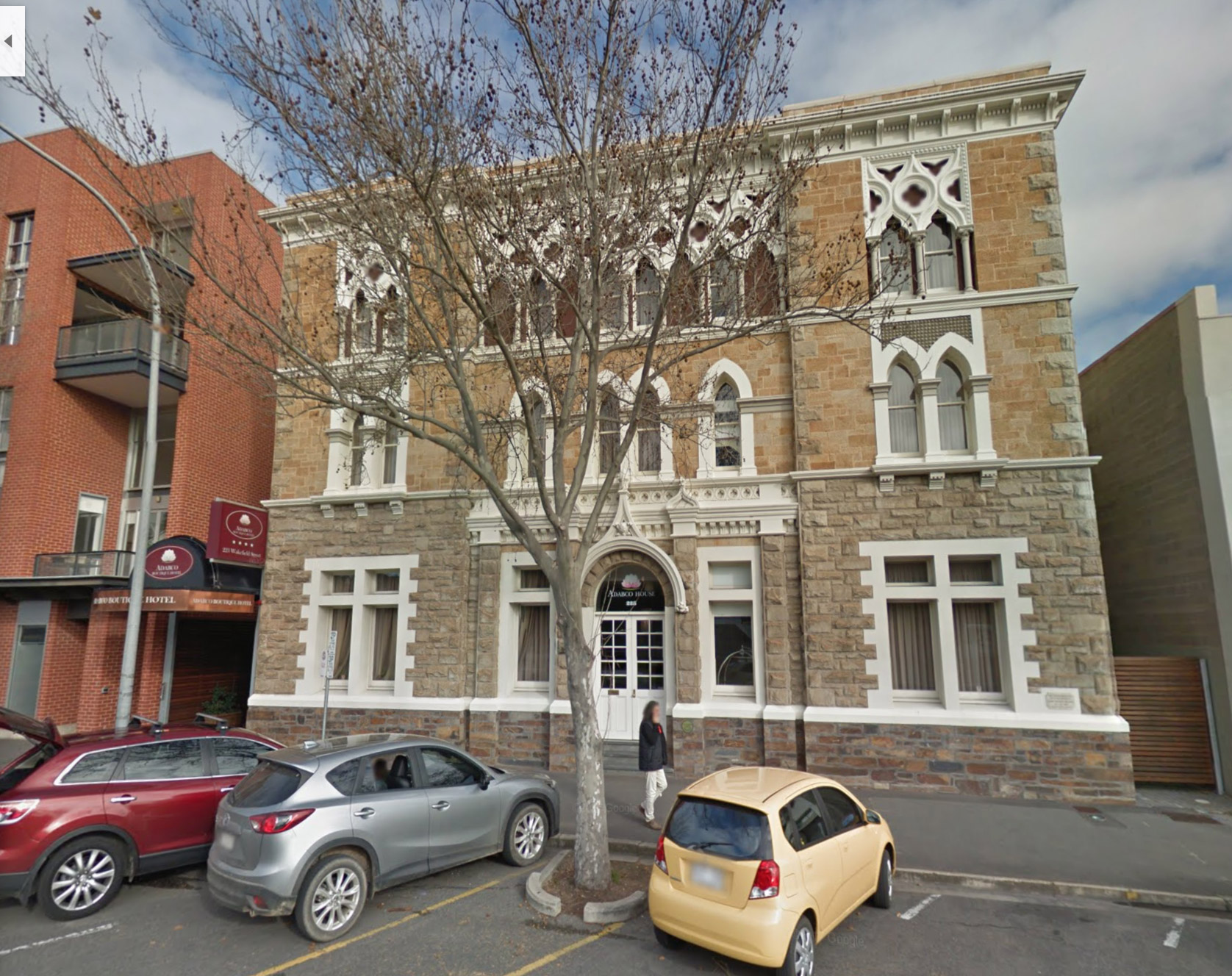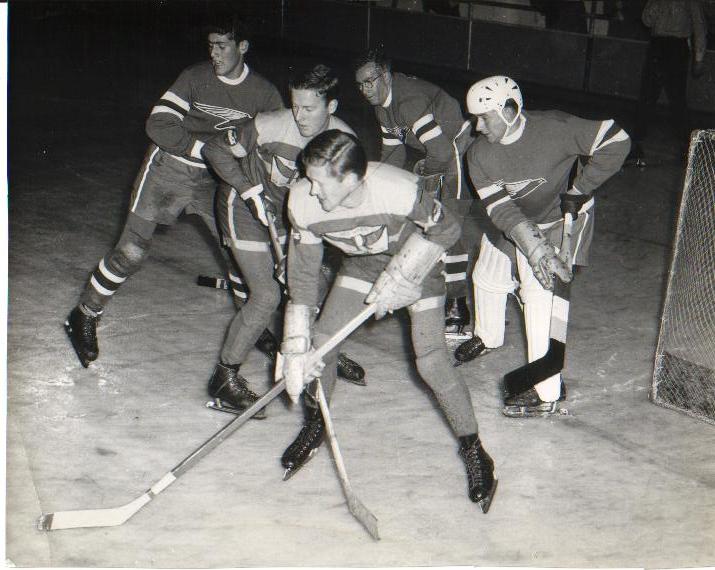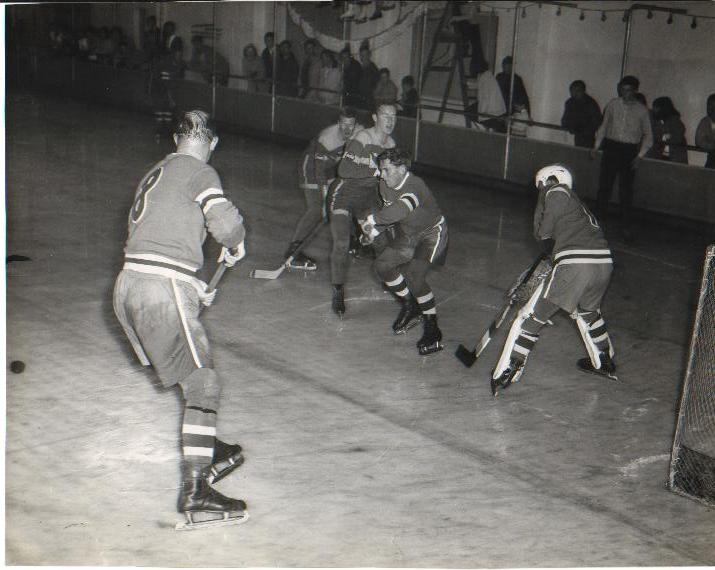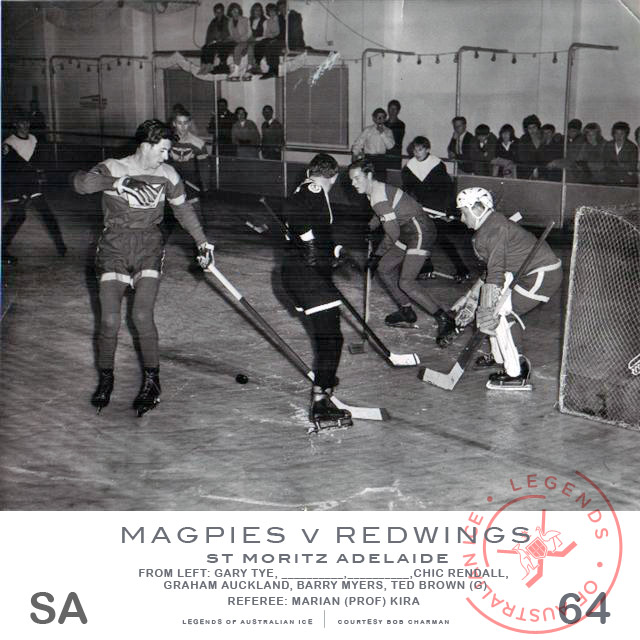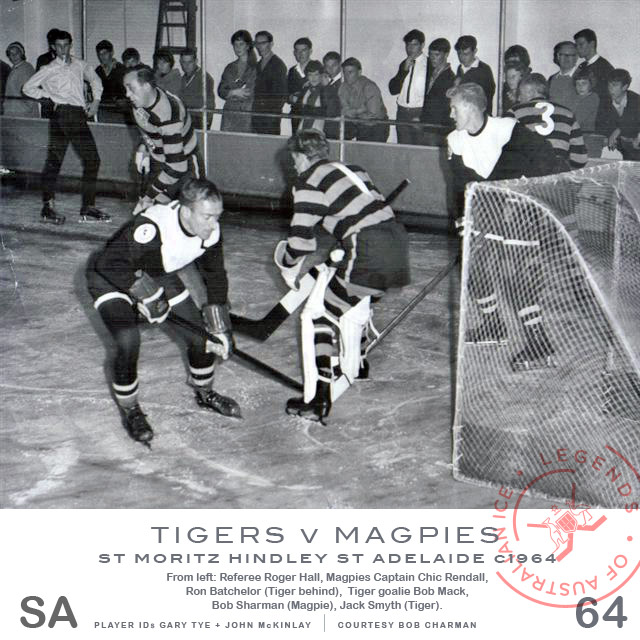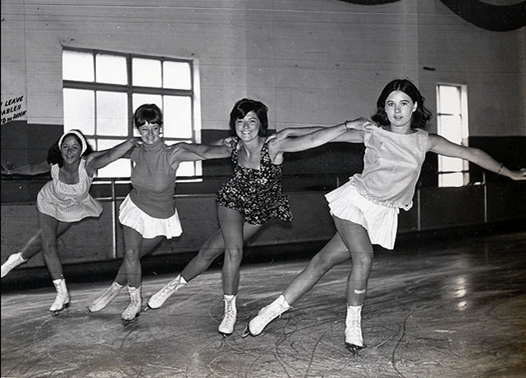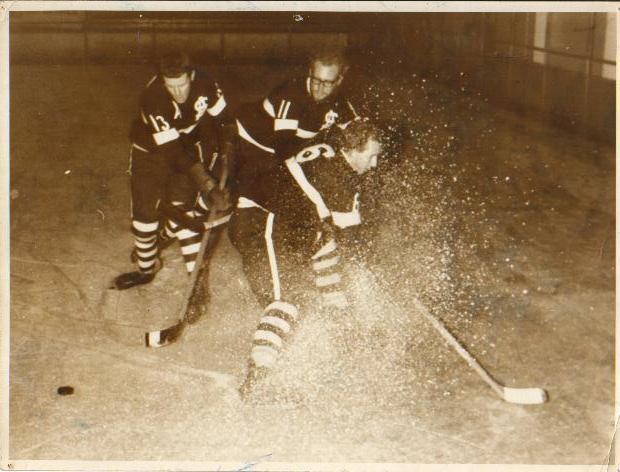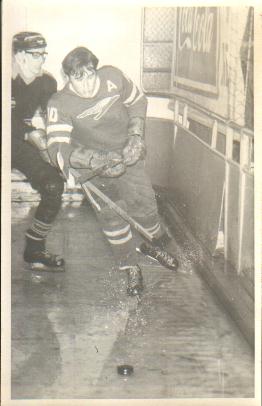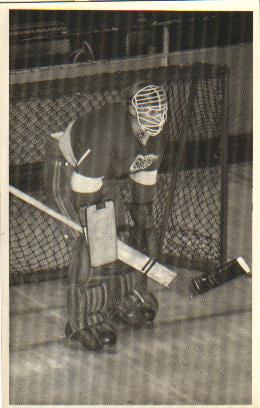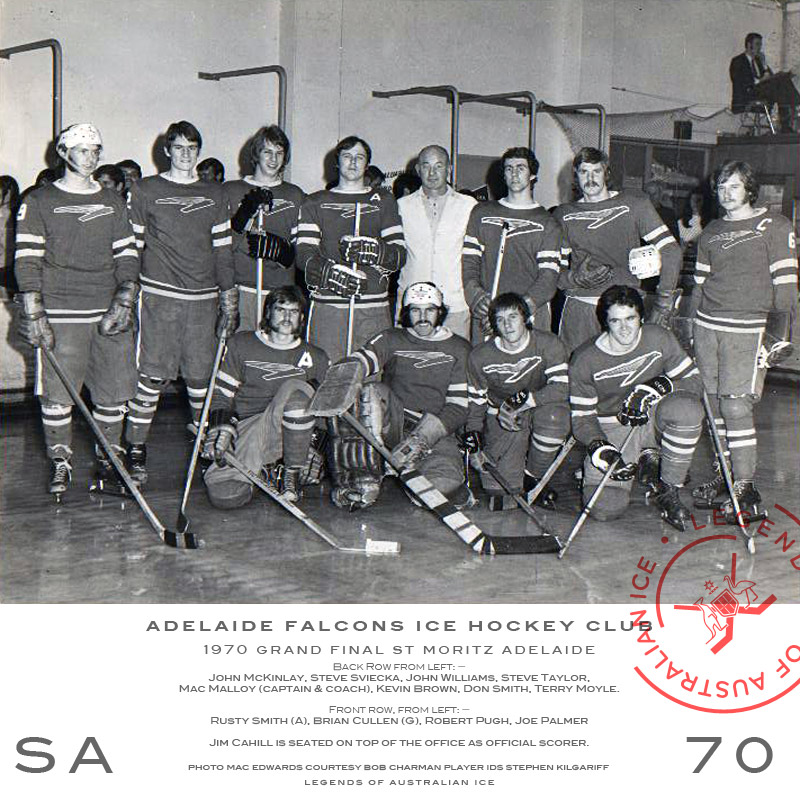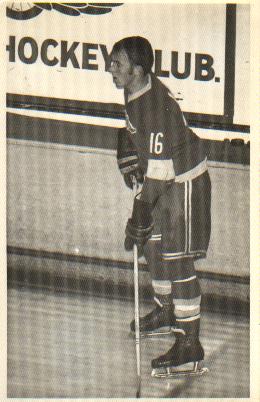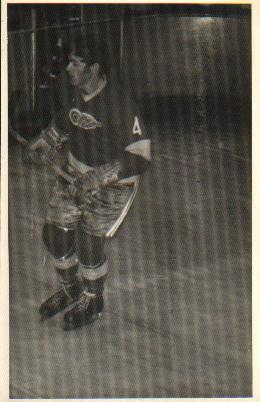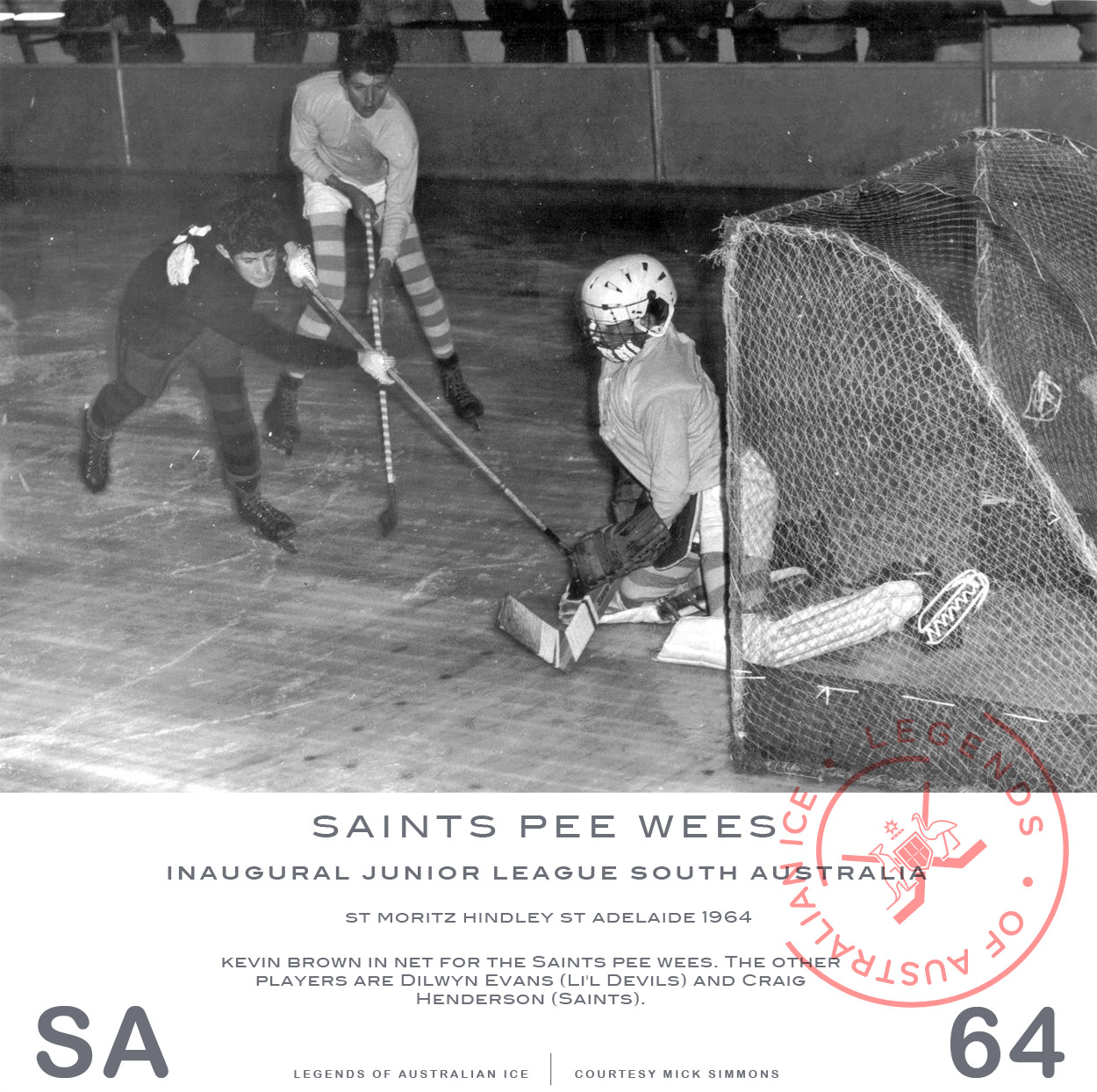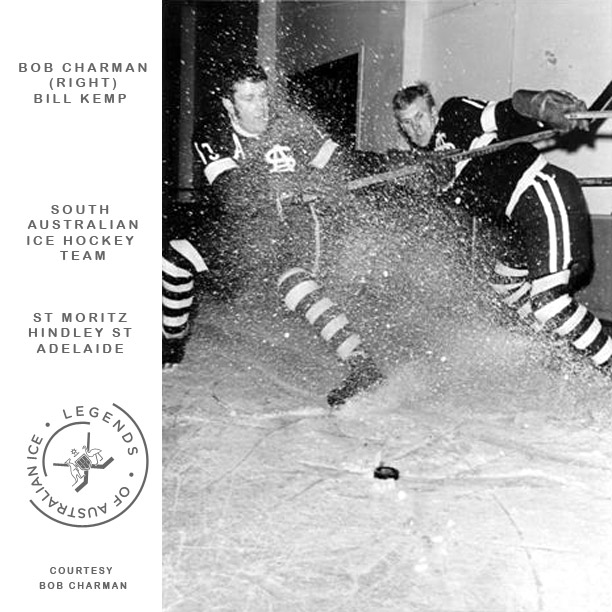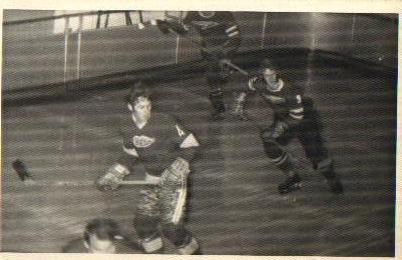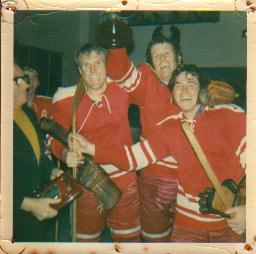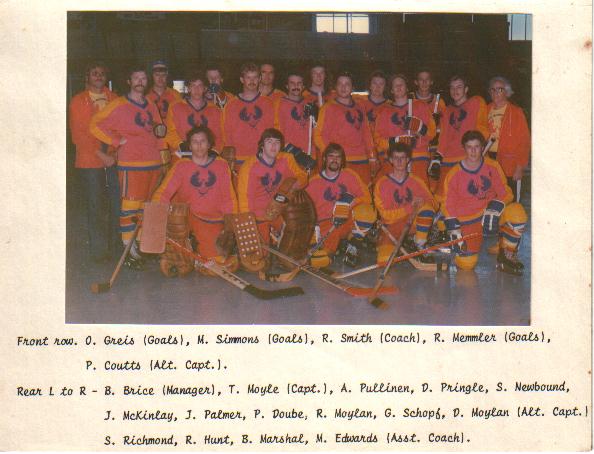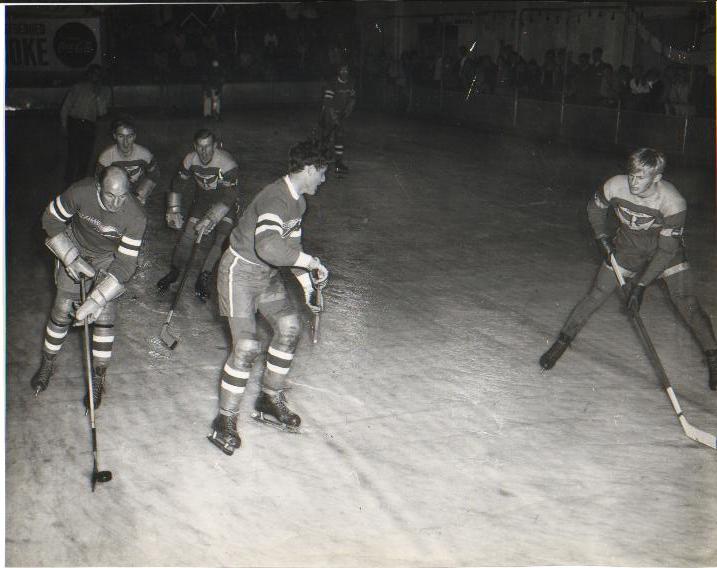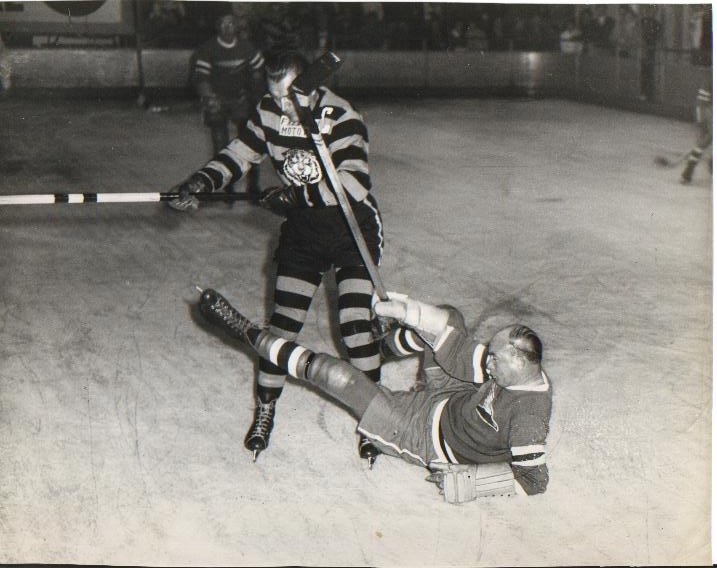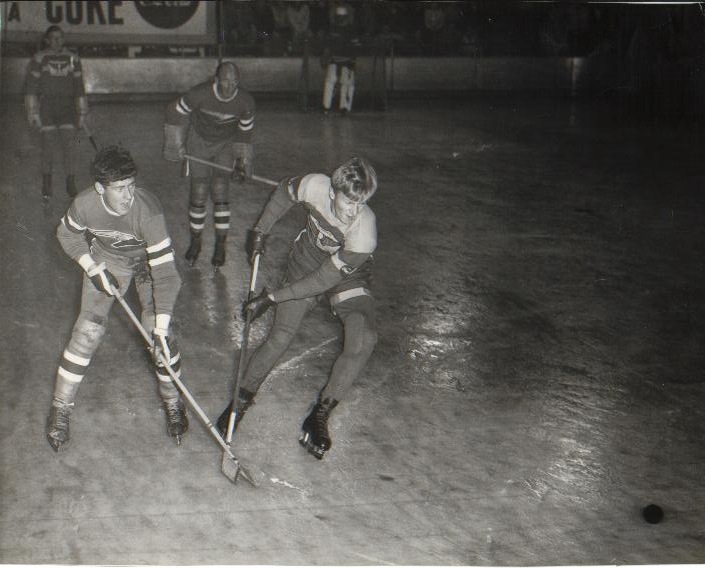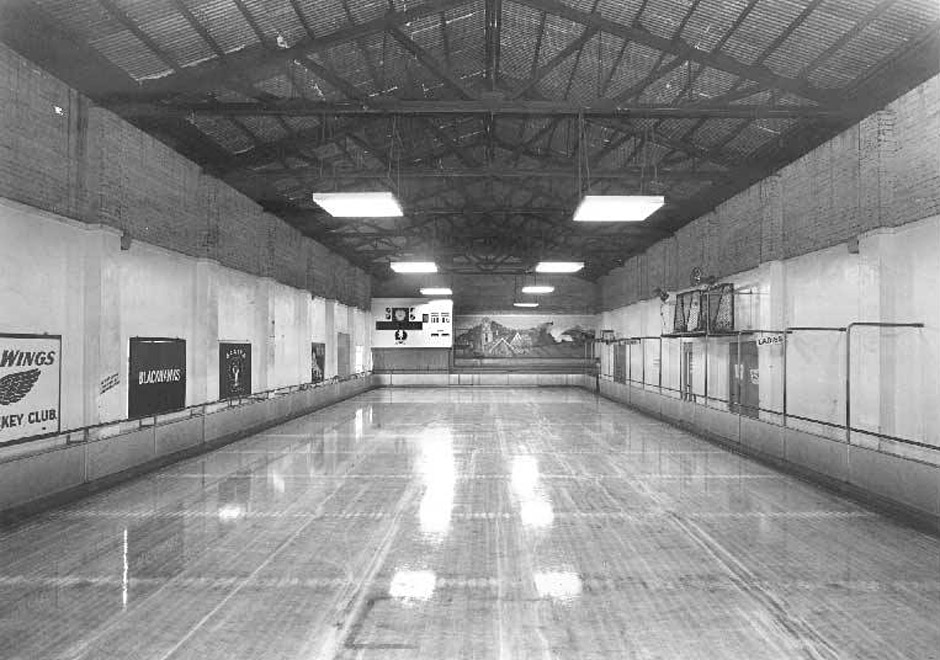
Neverland
Bill Young and the West End Boys
Ice hockey, the world's fastest team game, will soon be played regularly in Adelaide. Next month four senior and four "pee-wee" (under-15) teams will be chosen, and regular practices will begin at the St Moritz ice rink, Hindley Street. The first matches will begin in May. Due to the small nature of Adelaide's rink, the game played here will be a miniature of that played overseas, and in Melbourne and Sydney. Instead of six men a team being in play at the same time, there will only be four.
— Jim Cahill, an original referee, administrator and association secretary, reporting for a local Adelaide newspaper, April 1964. [1] ENTRANCE TO ST MORITZ ADELAIDE.
ENTRANCE TO ST MORITZ ADELAIDE.
Hindley St, September 4th 1971. State Library of South Australia.
ALL CITIES, EXCEPT ONE, GROW UP. The engineer H Newman Reid discovered this when he lived in Adelaide briefly in the early-1900s. The stuffy affluent origins of the place did more to inhibit development than promote it. The man who breathed life into the first experimental ice rink in Australia married an Adelaide girl in Melbourne. Later, when the opportunity arose, he moved the family to the City of Churches. His children attended St Peters while he developed the Glaciarium Ice Palace, connecting it to the state ice works in Light Square with a pipe network laid down in public streets and lanes.
Reid put his reputation on the line to deliver the first engineered ice rink in the country. "Especially as other engineers in Adelaide had pooh-poohed the idea of the establishment of the rink," noted Dr Angus Johnson, a city councillor at the time, "and expressed the opinion that it was impractical to maintain a sheet of ice at such a distance from the plant".[6] Even when open, some referred to it as a white elephant. When it was gone, the roller rink managers made jibes about it in the press to promote themselves at its expense. "Olympia. Late Ice Skating Rink, Hindley Street, Always Known as the White Elephant".[14]
The Lonely Planet Guide once described Adelaide as bogged-down in old-school doldrums and painfully short on charisma. A pious, inward-looking place. Even its mechanical engineers seemed predisposed to hypocritical displays of virtue. Perhaps there is something wholesome to be gained by defining yourself by the number of churches you have, but once upon a time, the street of which I speak had been the busiest in town. Eighteen hotels, dotted every sixty or so unsteady paces along its length, culminated in the distinctive tower chimney of the West End Brewery and its beloved West End draught beer.
Yet, retailing in Hindley street was all but dead after the Second World War and the western end, where Reid converted the old Cyclorama to an ice rink, remained semi-industrial. Later, British Empire Films and RKO Radio Pictures set up outlets there, and an entertainment precinct sprang up in the early 1950s to include fun parlours, followed in the 1960s and 70s by cabaret, strip clubs and nightclubs. It was sometime after that Adelaide lost its childhood innocence and ceased being Neverland, the Peter Pan of urbanity.
The sign above the gated stairs of the Con Liascos Building said "Ice Skating," but emblazoned across the verandah was the decidedly more spicy "Paprika Night Club". It was a fair dinkum club in the underground jazz scene of the 1950s and 60s. It had good live bands, a compere-cum-singer, and a very well endowed female performer named Patricia Kennedy (Wordsworth), who everyone called 'Big Pretzel'. Ice skating enthusiasts queued against its mezzanine walls on the broad stairs up to their first-floor destination, the smallest ice skating space in the country.
The short-lived Glaciarium behind the frontages on the south-side of Hindley Street way back in 1904 is the birthplace of Australian ice sports. But the rink established a short distance away fifty-five years later, in 1959, was the birthplace of South Australian ice hockey unless you are a purist and discount it for lack of a competition-size ice rink. Rather remarkably, it too had been connected to the state ice works in Light Square, probably with the same pipe network laid down in some of the same public streets and lanes. The rink developers, Ted Molony and Jack Gordon owned the St Moritz Ice Skating Rink on the Upper Esplanade of St Kilda in Melbourne. They also operated the old Glaciarium in Melbourne and were probably aware of the first low-cost experiment in Adelaide. What better way to re-introduce Adelaidians to ice?
As legend has it, Molony and Gordon held the original 1904 freezing pipes at the Glaciarium in Melbourne. When it closed in 1957, they were brought back to Hindley Street and installed in the St Moritz rink. They remained there until June 1966.[12] There were other marked similarities between these first two Adelaide rinks, such as the narrow street frontage of just 6.6m. Like its innovative forerunner, the second rink in Adelaide also provided access to a building behind, in this case extending about fifty metres west up to No 157, the Star Grocery, on the Morphett St corner.
The Star provided 'continental' foods to new arrivals and appreciative locals. Australia had not accepted non-British European immigrants until after the Second World War. The food and drink on offer in this part of the town changed with the post-war migration from eastern Europe. Fish shops had given way to pizza houses and eateries such as the Athens Restaurant and BBQ and the Paprika Club Restaurant. If you did not get to the shops before noon on Saturday in those days, then nothing was open again until Monday.
By 1959, the year the population of Australia reached ten million, Molony and Gordon simultaneously operated rinks in Melbourne, Sydney and Adelaide—the three survivors in the country after the original Glaciaria closed a few years earlier in both Melbourne and Sydney. That year they opened their third, the open-air rink at Prince Alfred Park in Sydney. Although interstate hockey still did not resume until 1961, Molony and Gordon had extended the vision of H Newman Reid more than any builder of ice sports before them. Their achievement was still unequalled six decades later, with the possible exception of Pat Burley.
The boutique rink in Hindley St Adelaide was also named "St Moritz" after the rink in Melbourne. It was a ubiquitous shade of green, synonymous with Sixties Australia with a mural of the Matterhorn on the back wall. Skaters still recall the soft black leather of the hire skates, far superior to the plastic-coated kind that later replaced them. Dimensioned at just 25m x 10m, it was well below the IIHF specifications of 61m x 30.5m. The space between boards and the side walls was no more than the width of a single passageway. Never intended for ice hockey, a tubular steel handrail design capped the boards, handed down over a half-century from the original Glaciarium a short distance away.
Steve Meharry first skated there in 1971 and was soon spending several sessions there every weekend. "There was always water on the ice," he remembers, "and skaters sprayed each other by flicking water up with their skates". There was no Zamboni, so keen skaters could earn a free pass to the next session by squeegeeing the ice. The water went down and out into the back lane via a chute rear left.
THE CARVED SANDSTONE FACADE of the Adabco Boutique Hotel in leafy Wakefield Street, Adelaide, is all that survives of the Our Boys Institute, a junior branch of the YMCA. Behind this Venetian Gothic wall, Bill Young taught roller skating on a new rink in the converted gym in 1937. Young managed the OBI Roller Hockey Club with secretary Mac Edwards when the OBI was the controlling body of the state Roller Hockey League. Eight affiliated clubs boasted names resembling the crack North American clubs—Red Flashes, Blue Streaks, White Knights.[11]
The rest of the original building is long gone; the lecture and games rooms, the indoor running track and pool. The OBI skating hall claimed expert tuition on "the fastest floors in the Commonwealth". The sport has evolved into something considerably more than racing round and round in circles as fast as possible.
OBI was the only city roller rink, with others at Unley, Seacliff, Glenelg and Semaphore.[4] The association ran amateur figure skating championships throughout the metro rinks, and roller hockey continued to be popular. It was played four players to each side, compared to six for ice hockey.
Sports nights were broadcast over 5KA and consisted of half-mile and quarter-mile races and hockey matches for the state championship. A team from Broken Hill played a series at OBI against a combined South Australian team.[3] Despite a long history in Adelaide, the sport was only recently recognised as "art" in popular culture due to the films Thin Ice and Happy Landing featuring Sonia Henie, which screened in Adelaide in the late-thirties.[4]
Bill Young became a skilled speed skater, figure skater and roller dancer on the crest of this new wave of performance art. He started roller hockey at 13 in 1940, playing at quad roller rinks throughout the 1940s and 50s with his friend, Mac Edwards. He started ice skating after installing freezing equipment at the new St Moritz ice rink. Transitioning quickly, he eventually coached and judged figure skating on ice.
In the early-1960s, Bill Young became the second rink manager of St Moritz. Molony and Gordon were initially unconvinced ice hockey could be played there, even just for recreation. However, Young and his old roller skating colleagues, Ted Budarick and Mac Edwards, thought otherwise. They called for players and ran a recruitment drive among the better skaters at a Christmas party scratch match they had organised at the rink. Young then convinced Ted Molony to give ice hockey a try, and it was not long before the local skaters proved the rink owners wrong. They made their gear from newspaper and foam and played shinny for a year during 1963.
The owners were impressed and allowed competition ice hockey. Matches were three-on-three, less a winger and defender, just like the roller hockey played and taught by Young and Edwards, but on ice.[11] Games were played over two twenty-minute periods on Thursday nights at 9:30 pm after general skating with training for an hour from 7:00 am Sunday.
The first senior league formed in 1964, initially comprising the Falcons, Magpies, Redwings, Tigers and the Maple Leafs mid-season. The names of two of these clubs paid homage to contemporary North American National Hockey League teams. Bob Charman for the Magpies and the John McKinlay for the Tigers took the first face-off on May 21st 1964, from which the Tigers emerged victors, 11-4.
Captained by Ron Bachelor, the other Tigers were the big, fast forward, Clive Thompson, Freddy Fredricks, Jack Smyth, Bob Mack, and Dave Lynch, who became state speed skating champion in 1966, moved to the Redwings in 1968, then went to Vietnam and moved back to the Tigers on his return in 1970.[9]
The Magpies, captained and coached by Chic Rendall, were Ian Haye, Peter Hunter, Barry Myers, Gary Tye, and goalie Bob Harnass who moved to the Redwings in 1966, won premierships in 1967 and 69 and became president of the state association in 71. Charman also later moved to the Redwings as a defenseman.[9]
A figure skating exhibition followed the first match of the opening night, and then the Falcons played the Redwings. Bill Young was the Redwings captain and coach with alternate captain Graham Ackland, Ted Brown in net, Barry Probert, Joey Vancek, Vans Pukk, John Stockley and Jeff Lintern. The Falcons, captained by Mac Edwards, were sponsored by the Ford car dealership in Franklin St and named after the new Ford car.[8] Some of the leading firms sponsored teams. Edwards later played in two premierships with the Redwings.
Mac Malloy, foundation coach with the Falcons in 1964 and '65, had played for the Red Devils in the first Tasmanian League, representing that state in the 1952 Goodall Cup. Employed at Dalghet, he was a Canadian international who reputedly had coached the Dutch National team. "A big man with great skills," recalls Stephen Kilgariff," A strong skater with a very good wrist shot. He didn't mind taking on anyone and taught the young players to keep their heads up". The other Falcons included Wayne Abbot, Bob Trott, Geoff Brown, Ron Sullivan, and goalie Dean Gum. Roger Smith officiated the very first game between these two sides.
The Leafs entering the comp midway took the little barn in Hindley Street by storm and the first state Premiership. Among their players were Alan Dyer, Val Pukk, Jim Beatty, Chris Fennell, who had a very accurate wrist shot developed in the Canadian junior leagues, and Joe Szuna, who later played for both the Tigers and the Redwings. Szuna became state speed skating champion in 1969.
The Maple Leafs dropped out the year after, and the short-lived All-Stars formed for one season, morphing with several other players into the Blackhawks in 1966. Otherwise, the South Australian ice hockey league is essentially the same today as the foundation league. Young also started the first Pee Wee (U15) league in 1964 with the Blackhawks, the Li'l Devils (1964 Premiers) and the Saints training and playing on Saturday mornings.
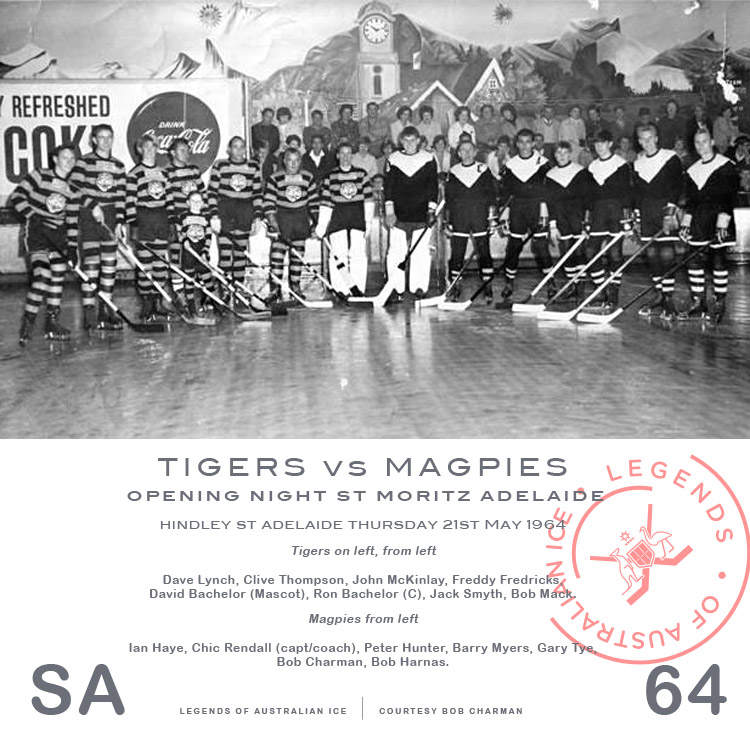
The second ice hockey season began on April 1st with six teams; the goals made to international standards; two referees instead of one; two matches a night; and no half-time break. The teams changed ends immediately after the first half.[10] Then, on October 10th 1965, South Australia iced its first unofficial state ice hockey team against the Pirates B-Grade in Melbourne.[5]
In 1966, the third season of hockey in the state, Bill Young formed the St Moritz Ice Hockey Club. It was the first state ice hockey association, and Young was the first president. That year in Melbourne, the first official State team launched. South Australia played for the Brown Trophy against New South Wales, Victoria and Queensland for the first time. Young was state coach, pitted against teams stacked with imported overseas players. The squad was: Ted Budarick (C), Joe Szuna (A), John McKinlay (A), local goalie Dean Gum, Bob Harnass, Chris Fennell, Colin Clarke, Alan Dyer, Bob James, Rusty Smith, Geoff Brown, Gary Tye, Richard Williams, Bob Avermarg, Jeff Lintern, Dave Lynch, John Stockley, Alan Parman, Barry Probert, Bill Kemp and Chic Rendall. Bill Young was Coach, and Herb Tye was the Team Manager.[13]
Many played the foundation games in 1964. Captain Ted Budarick played centre for the Redwings. Goalie Dean Gum had played three seasons in goal for the Falcons and once in Melbourne in 1965. Bob Harnass from Holland was the Redwings goalie. David Lynch was a very speedy winger who had twice won the state speed title, playing his second year with the Redwings. John McKinlay was a figure skater and held both junior and senior speed titles. Richard Williams held bronze and silver medals in figure skating and was in his first senior year with the Falcons, having played two years with the juniors. Rusty Smith, a junior player the previous year, was a winger and a good puck handler and scorer. Joe Szuna from Hungary was a very determined winger with the Maple Leafs. Bob Avenmarg was a foundation member of the Blackhawks and a hard-hitting defenseman.[13]
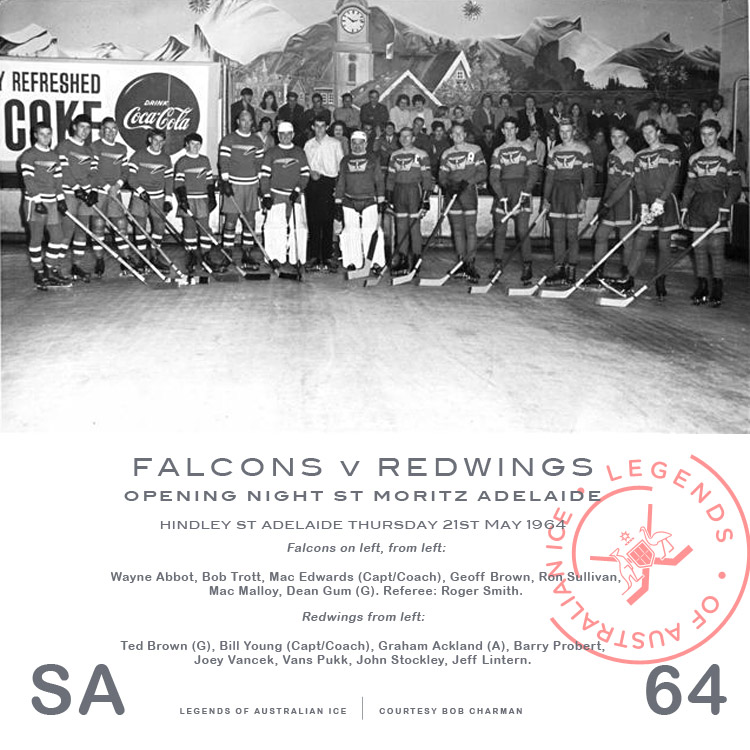
In October 1967, Young coached a state team against sailors from HMCS Yukon, a Canadian Navy vessel visiting Port Adelaide on a "show the flag cruise" in the Canada Centennial year. The match finished in a high scoring draw, twelve or thirteen apiece. "The story goes," writes Rusty Smith, "that some of the Yukon players had to be bailed out of the brig to play. Must have had a big night on arriving in Adelaide". It was the first international game played in the city. Rusty Smith and Kevin Brown both played, and both enjoyed long careers in the sport. At 16, Smith was the youngest member of the first state side. Brown became the president of the national association.
In 1969, Rusty Smith and Stephen Kilgariff made the Australian All-Star team from the competing Brown Trophy and Goodall Cup teams. They were the first national representatives in ice hockey in the state. They heard about it when the national association announced it at the Journalist Club in Sydney after the tournament. The state played its first Goodall Cup in Sydney in 1977 after being 'promoted' in 1976, but Queensland won its first Cup after the organisers cancelled the Finals.
The figure skating club organised regular competitions, and bronze, silver and gold medals were awarded for skating proficiency. South Australia sent skaters to compete in the Australian Figure Skating Championships. Bill Young's wife Shirley was involved with the rink, and daughters Beryl, Janet and Karen took up figure skating. Karen changed to speed skating in 1985 and competed in three Olympics—Calgary in 1988, Albertville in 1992, and Lillehammer in 1994. She married short track speed skater John Kah, one of the four Australians to win the 5000m relay at the World Championships in 1991 in Sydney. It was the first time Australia won a World Championship in a winter sport.
Young sold St Moritz in 1978 as the proposed new Olympic-size rink at Payneham loomed, threatening to drain its patronage. Eventually left with insufficient income to keep afloat, the tiny boutique rink closed in 1979. During the in-between years, many other notable ice hockey players competed 3-on-3 on the small ice of St Moritz. They are too numerous to mention, but among them were the big defenceman Bill Kemp who started in 1965 with the Redwings; Ted Budarick, who at 34 became captain of the first state team in 1966; Joe Palmer, who began as Joe Peremiszco, a defenseman in the early-70s; and Martin Hosking, who played in the mid-70s.
Steve Sviecka, a Redwings junior player from 1968, moved to the Falcons in 1970. Redwings defender Mick Peglar was a good skater with a strong wrist shot. Bill Vis started in 1965 with the All-Stars wearing West Adelaide football club jumpers. The Englishman John Durham got very red in the face minding the net for the Tigers. Steve Oddy married Janet, a daughter of the Youngs, and later co-founded the Australian Ice Hockey League and the Adelaide Avalanche. Peter Siddons, an original player with the Li'l Devils in 64, moved to the Blackhawks in 67.[9]
Behind the rivalry, there is a kind of brotherhood between Adelaide and Melbourne ice sports, a kinship linked by shared beginnings—not once, but twice. The twenty-year association Bill Young had with St Moritz Adelaide was made possible by Melbourne developers, mirroring the making of the first rink there in magical ways, right down to their common foundation on quad roller skating. With that help, Young wrote local history until 1979 when another chapter opened at Payneham in the northeast. In that time, he laid the foundations of organised local ice hockey in South Australia, extending the vision begun by H Newman Reid in the same street sixty years earlier and launching state ice sports onto the national and international stages.
Some scholars partly attribute the early stuffiness of Adelaide to its founding as a free enterprise. It was not a penal settlement like every other state capital except Melbourne. Both were free settlements, but unlike Adelaide, the street grid of Melbourne is devoid of squares and public meeting places in an attempt by the authorities in New South Wales to discourage democracy through public gatherings. Melburnians have always defied this by taking public expression and vocal activism to their wide streets. Although Adelaide and Melbourne have very different cultures, they resonate.
Bill Young eventually became the first life member of the Adelaide Redwings, and his leadership in ice sports over the years saved many young men from losing their way.
Special thanks to Stephen Kilgariff, Bob Charman and Mick Simmons for their generous contributions.
[1] Jim Cahill, unidentified newspaper, Adelaide, April 1964. Courtesy Bob Charman.
[2] "South Australia's First Ice Hockey Team", Mark Skinner, Unidentified newspaper, Adelaide. Courtesy Bob Charman.
[3] "New 'Art Sport'," Sport newspaper, Adelaide, 25 Aug 1939, p 3.
[4] "Adelaide Girls are Enthusiastic Skaters," The Advertiser, Adelaide, 19 July 1938, p 7.
[[5] Mick Simmons, Ice Hockey South Australia historian, March, 2016
[6] Dr Angus Johnson, Adelaide City Councillor and Chairman of the Adelaide Health Committee, May 1905. The Advertiser, 22 May 1905 p6
[7] Mac Edwards Photograph archive courtesy Bob Charman, captions by Stephen Kilgariff and Mick Simmons
[8] Rusty Smith, Facebook comment, Easter 2017.
[9] Questionnaire responses and biographical notes provided by Stephen Kilgariff, Bob Charman, Mick Simmons et al, March 2017.
[10] "Ice Hockey on April 1," The News, Adelaide, March 20 1965, p 11.
[11] "No Ice Rink is Needed for these Hockey Fans," unidentified newspaper, Adelaide, undated. Courtesy Bob Charman.
[12] "But What are a Few Bumps and Bruises?" Sunday Mail, July 9 1966, p 32.
[13] Ice Hockey Guide, Australian Ice Hockey Federation, July 30 - Aug 2 1966
[14] Olympia Roller Rink advertisement, Advertiser, December 21 1907, p 2

First State Team.
Brown Trophy, Melbourne, 1966. In no particular order: Ted Budarick (C), Joe Szuna (A), John McKinlay (A), local goalie Dean Gum, Bob Harnass, Chris Fennell, Colin Clarke, Alan Dyer, Bob James, Rusty Smith, Geoff Brown, Gary Tye, Richard Williams, Bob Avermarg, Jeff Lintern, Dave Lynch, John Stockley, Alan Parman, Barry Probert, Bill Kemp, Chic Rendall, Bill Young (Coach), Herb Tye (Mgr)
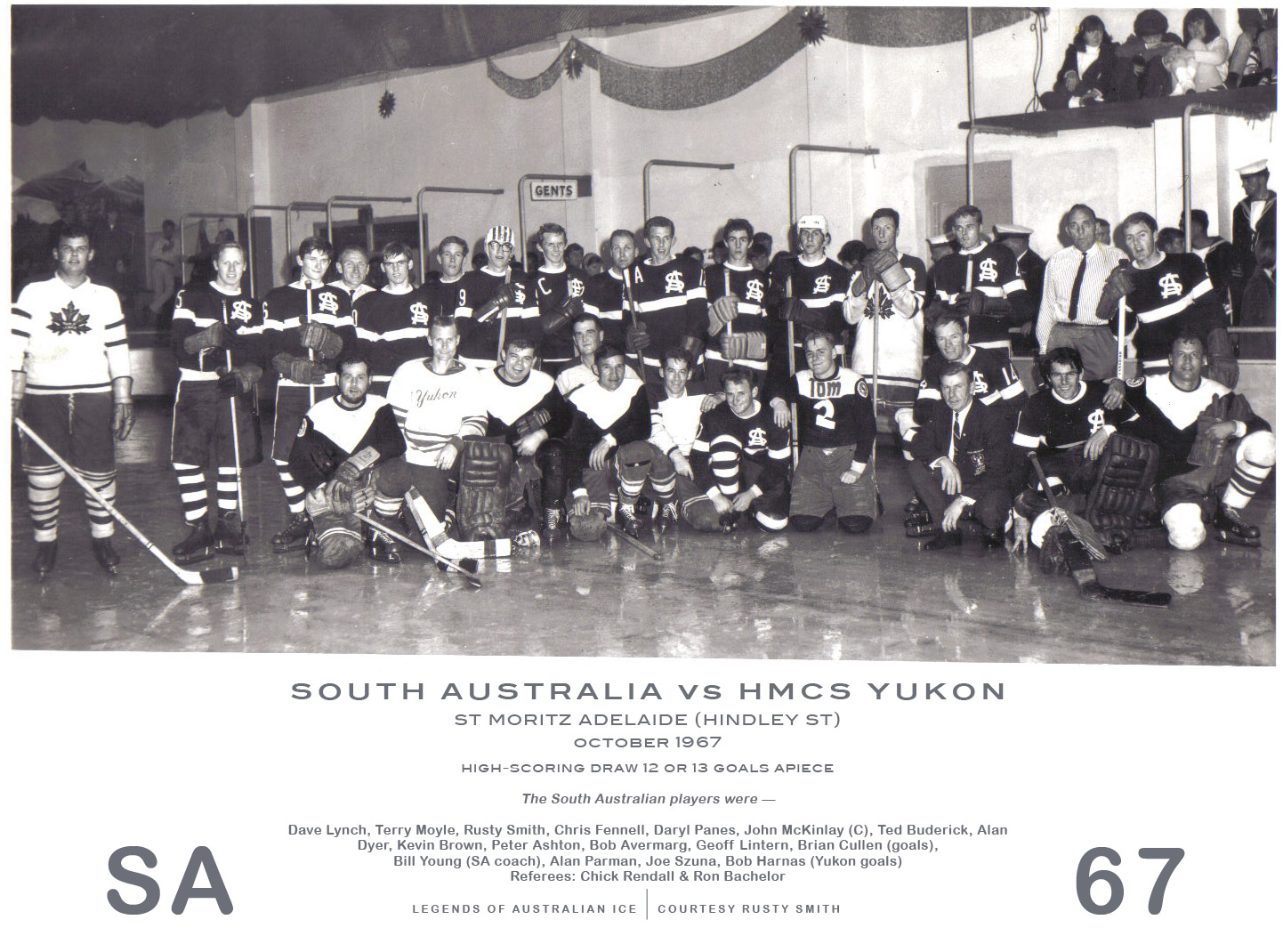
Yukon v South Australia
St Moritz, Adelaide, 1967. Courtesy Rusty Smith. Dave Lynch, Terry Moyle, Rusty Smith, Chris Fennell, Daryl Panes, John McKinlay (C), Ted Buderick, Alan Dyer, Kevin Brown, Peter _____, Bob Avermarg, Geoff Lintern, Brian Cullen (goals), Bill Young (SA coach), Alan Parman, Joe Szuna, Bob Harnas (Yukon goals). The referees were Chic Rendall and Ron Bachelor.
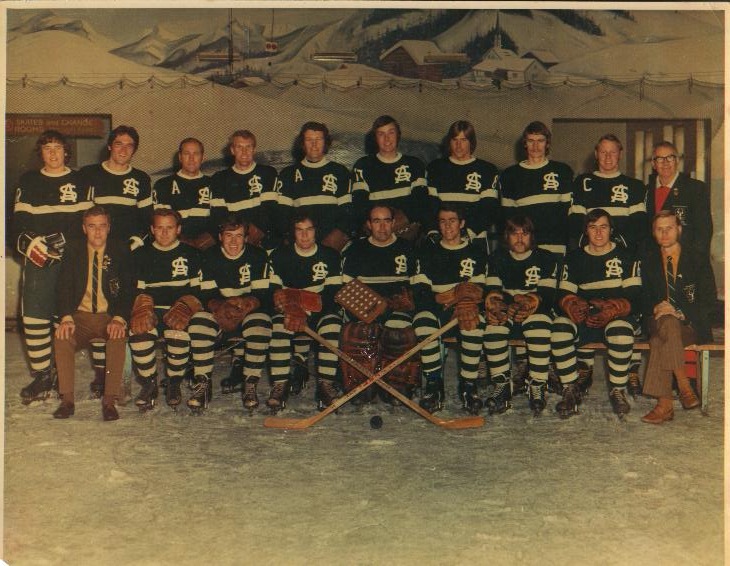
1969 State Team
Back L-R: Marty Hosking, Joe Palmer, Ted Budarick, Bob Charman, Bill Kemp, Clive Thompson, Bill Vis, Steve Sviecka, Dave Lynch, Mac Edwards (Coach). Front: Jim Cahill (Mgr), Joe Szuna, Stephen Kilgariff, Mick Pegler, Johnny Durham, Kevin Brown, Rusty Smith, Peter Siddons, Bob Harnass (Asst Mgr).
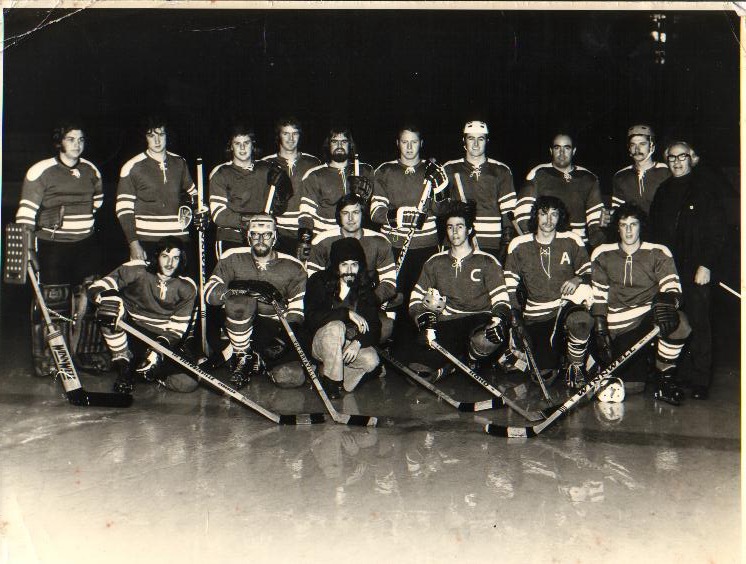
1975 State team
Back L-R: Brian Johnson (Goals), Peter Fletcher (Canadian), Chris Tait, John McKinlay, Rusty Smith, Dave Lynch, Peter Siddons, Johnny Durham (G), Terry Moyle, Mac Edwards (Coach). Front: Brian Reaney, Jim Beatty, Clive Thompson, Ken Hall (front Team Manager), Kevin Brown (C), Gary Logie (Canadian) and Peter Coutts.


